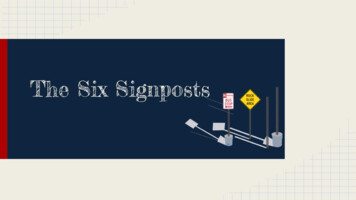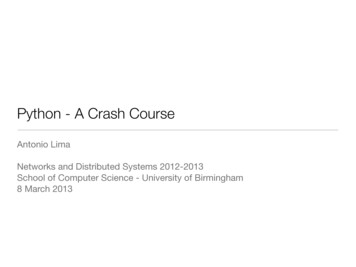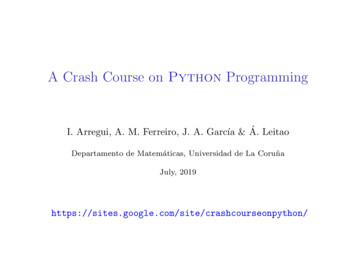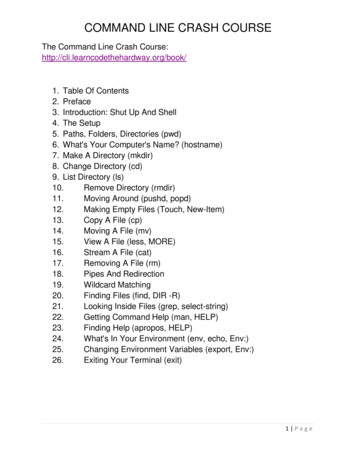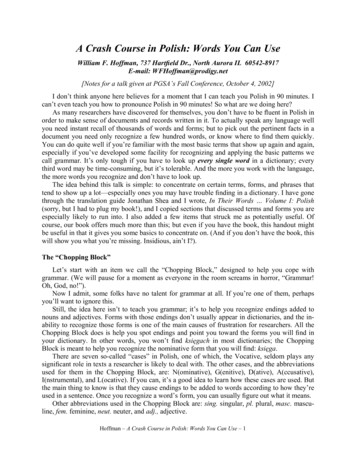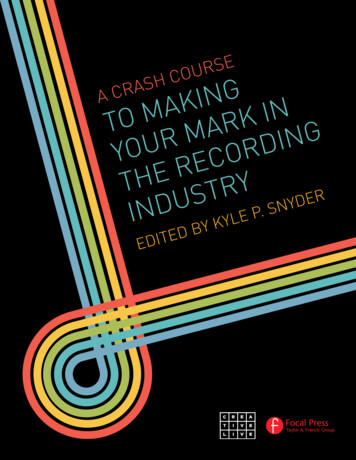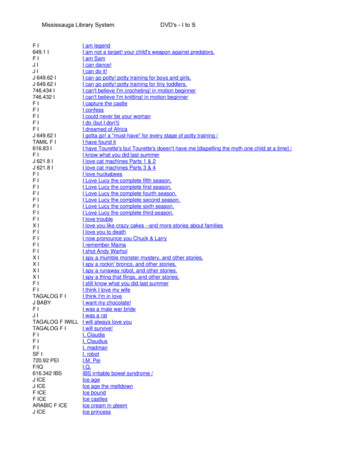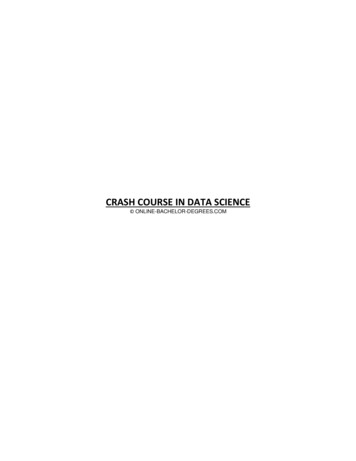
Transcription
CRASH COURSE IN DATA SCIENCE ONLINE-BACHELOR-DEGREES.COM
OutlineA. Introduction: How Data Science Became a Prime Business and Research ToolB. Course Objectives and LimitationsC. Course Propera. What is Data Science?b. Data Science Versus Other Commonly Misused Termsi. Big Dataii. Machine Learningiii. Artificial Intelligencec. What Do You Need to Know: the Very Basicsi. Programming Languages1. Python2. Rii. Math (Statistics)d. Processes of Data Sciencei. Data Acquisitionii. Data Explorationiii. Data Modelling and Visualizatione. How to Become a Data Scientist if You're .i. An Undergradii. An Experienced Professional or a Career-shifterD. References
INTRODUCTION
How Data Science Became a Prime Business and Research ToolData has always been around, but it has never been more prevalent, illustrative, and predictive of events,trends, and even human behavior than it is at present. It is now a prime business and research tool as itenables individuals, groups, enterprises, and even governments make sound and well-informed decisionsnot based on a hunch, intuition, probability, or previous experiences, but based on data that depictscurrent movements or behavior, or can even predict or forecast trends or events based on current data.Video Clip 1: Uses of Data Science Today.Data Science YouTube Channel. November 24, 2017https://www.youtube.com/watch?v e242eYPq0nEWith businesses from all sectors or industries utilizing data to leverage or move their businesses forward,this created a huge demand in the job market for data scientists or professionals who have experience instatistics, programming, analytics, communications, and even project management. In 2020, job portalGlassdoor ranked the job post data scientist as the third best job in the U.S. Furthermore, the Bureau ofLabor Statistics estimates the job growth of the field by three-fold. Besides data scientist work being alucrative, multi-specialty career that pays a hefty 100k a year, what else does this tell us?Anyone can be a data scientist, and you don't have to be an I.T. major to gather, handle, process, andinterpret data. Don't let the word "data" throw you off. Data science is a vast field that encompassesvarious fields: I.T. – part and parcel of data science is programming, and the common programming languages ituses to harvest and analyze data are Python and R, both of which will be briefly discussed in thesucceeding sections. Software engineering and cloud computing are also advantageous skills inthis fieldMathematics – also part and parcel of data science is mathematics, specifically statistics. A 2017paper featured in the International Journal of Data Science and Analytics noted how statistics playan integral role in almost every data processing cycle step. Knowledge of algebra and algorithmsare also essential.Analytics – this is more of a skill than a field, a skill that is vital in any field that deals withquantitative dataAny non-computing field – why is this relevant? It is important to realize that data exists in anyindustry, whether it be financial, I.T., medical, military, sports, or any other field, and knowing the
specific business processes involved in any of these industries is equally essential in putting thedots of data together to piece the whole story and make viable and relevant decisions from it.So, in simplest terms, what is the objective of data science? Why is it an indispensable business, research,and decision-making tool?If you missed it in the last bullet, here's why.It pieces the whole story. The various methodologies involved in the whole data science cycle helpsconnect the dots of data to stitch the bigger picture. With effective storytelling and visualization, a picturecan reach even the least technical people or the novice conversant in the room.That's the power of data. What makes it science is the methodical processes involved from the collectionphase, processing, interpretation, and visualization. In this crash course, we will present the basics of datascience that should give any novice reader on the topic enough to go on or a good starting point to furthertheir reading and self-learning.Video Clip 2: Storytelling with Data by Cole Nussbaumer KnaflicTalks at Google YouTube Channel, November 12, 2015https://youtu.be/8EMW7io4rSICan you imagine how business decisions were made before datascience come to prominence?
OBJECTIVES AND LIMITATIONS
Course Objectives and LimitationsTo say that this course's objective is to impart fundamental or even just an idea of what data science isand how essential it is in many enterprises today is a given.Think of this section as a foreword instead.This crash course aims to introduce novice readers like you to the topic, whether you're an incomingundergrad who's still on the fence on what to pursue in college or what courses to take or an experiencedprofessional looking to take the plunge on the data science bandwagon or looking to make a definitecareer move into this ever-growing multi-specialty field.Yes, data science is a multi-specialty field, so it is sometimes difficult for beginners to choose a startingpoint. Do you learn Python or R programming first? Do you learn Python programming only or R only? Willlearning statistics be enough? This crash course will not go into the details of Python or R programming,nor statistics and others. It will, however, provide basic information on these topics and other topicsrelated to data science.The basic information will be limited to its definitions, its uses or purpose, and how it is utilized in thecontext of data science and its cyclical processes.
COURSE PROPER
What is Data Science?As an interdisciplinary field, data science can be difficult to define as it is ever-growing and ever-evolving.As we said in the previous sections, data is nothing new. It had always existed even before computerscame about. Data is the elemental form of information. Numbers, quantities, metrics, units of measure,and other descriptors, are all data. Without any methodological processes, these data would be just that– data.But behind those numbers and other descriptors is a story. That's where the "science" in data sciencecomes in. if you think about it, data science is the product of years, or even decades, of a collective effortby various professionals or data specialists to apply scientific computing methods to refine the processesof collection, manipulation, analysis, and visualization of large volumes of data.Image from nalytics-vs-machine-learningarticle#: :text %20mechanical%20process.
Data Science Versus Other Commonly Misused TermsData Science versus Big DataThese two terms are usually equally mentioned in one sentence. Other times, they are mentionedsynonymously. Whereas data science is an interdisciplinary cyclical process, big data, as the word implies,refers to volumes and volumes of data and the processes involved in gathering these, how to store them(which involves building infrastructures for scalable processing and storage) and how to query them forretrieval purposes.Data Science versus Machine LearningThese two are not used synonymously but are usually used in a sentence in conjunction or next to eachother, i.e., complementary. That being said, instead of putting these two terms at odds against each other,let's see how these fit together.Data Science, being the interdisciplinary field that it is, takes on a broader perspective. To put it in realisticterms, those in this field are either called data scientists or architects. They deal with larger projects orproblems, or the bigger picture, such as raising market share or increasing market exposure of a product.In other words, it usually deals with intangible problems and solutions. On the other hand, MachineLearning, as the name suggests, is more focused on creating tangible solutions through algorithms. Theexpected outcome of machine learning is based on formulated requirements based on the analysis ofdata.In short, and using a normal Google query as an example, data science is responsible for populating searchresults (and its rankings), while machine learning is responsible for smart search features like voice search,autocorrect, and predictive text.Data Science versus Artificial IntelligenceThe simplest way to differentiate these two concepts is by looking at how they treat data. Data sciencetries to make sense of what the data is trying to say through different tools like statistics, while A.I. usesdata to implement machine learning algorithms thus, allowing machines to respond and behave based onexpected outcomes. Those expected outcomes are usually based on known human responses andbehaviors.In short, data science tries to understand data while A.I. implements data.
Image from s-deeplearning-50d3718d51e5The image above is a perfect yet simple depiction of the bigger scheme of things in the data world. A.I.encompasses machine learning and deep learning, and big data, and all these have a symbioticrelationship with data science. And although data science can and is a stand-alone discipline, its purposeis greatly defined by how A.I., ML, big data, and other related concepts such as deep learning utilize itsresults through various implementations. Without A.I., etc., data science seems like a concept that's onlygood on paper, or, like a law or bill that exists but is not implemented at all, rendering it useless.Differentiate and relate with data science these two other terms: Deep Learning StatisticsWhile we know, based on the diagram, that Deep Learning has the samesymbiotic relationship with Data Science, what about Statistics? IsStatistics really a part of Data Science or is it the other way around? Howare these two related?
What Do You Need to Know: the Very BasicsLike we have mentioned countless times in this piece, Data Science is an interdisciplinary field. But amongthe sea of skills, a data scientist must possess the indispensable or essential ones? Let's briefly go througheach:1. Python ProgrammingPython has been around since the early '90s when Guido van Rossum created thelanguage with influences from the ABC language. What's appealing with Python is its easeof use, simplicity, flexibility, and generality.Python is not an original language per se. Think of it as a combination of syntaxes forvarious purposes like internet protocols, text processing services, binary data, variousmodules like mathematical, numerical, programming, O.S. interfaces, data processing,compression and archiving, and many more. Many of the codes are written in C, whichmeans it is not self-hosting, but basic data types like strings, dictionaries, numbers, andlists are enabled and are extensible to C and C .Is it advisable to learn Python right away for beginners? Are there any pre-requisitelanguages necessary?Learning fundamental programming languages like C, C , or even Java is a definite plus,but remember when we said that Python is simple? Here's how simple it is compared toJava:Image from ent/whypython#: :text 20confusing%20syntax.Python gets to the point compared to syntax-heavy languages like Java. For beginners,this is a great advantage and a great motivator because, as we said, it gets straight to the
point. It allows the beginner programmer to develop the mindset of a programmer. Someprofessionals may say that this – simplistic learning - puts the beginner at a disadvantage,especially in the long run, so again, it's a matter of preference for the novice learner. Butif the end game is to learn about data science in an expedited fashion, then there's noharm in learning Python as your first programming language.Companies and applications that use Python include Dropbox, Google, Spotify, andNetflix. At Google, Python is employed along with C . It gave Google the perfectcombination of low maintenance with high efficiency (Python) and low latency withefficient memory (C ). Other apps like Spotify and Netflix use Python mainly for dataanalytics.And finally, not only is Python simple, but it is also stable. How stable? The companiesmentioned above use Python for their web-based and or mobile apps and for desktopbased clients, which speaks to the cross-platform usability and stability of the language.Cross-usability of a language adds to its power because developers can use it to createalmost anything in various media forms to be implemented across platforms.These are the reasons why Python is also widely used in data science, with about 2 out of3 data scientists using Python for their daily data tasks.Video Clip 3: How Is Python Used In Data Science? [For Beginners!] by Kim FesselCourse Report on YouTube Channel. September 15, 2020.https://www.youtube.com/watch?v FUc7QML8dU&feature youtu.be2. R ProgrammingR Programming was launched by New Zealand statisticians Ross Ihaka and RobertGentleman (which is probably where the "R" in R programming came from). Part of itslanguage is written in R. It is self-hosting. It is also partly written in Fortran and C.Whereas Python is a multi-platform, multi-purpose programming language, R is writtenfor statistics and the subsequent computations and visualizations needed.
Both R and Python are used in data science. Each programming language has its strengthsin the context of data science. For example, Python is more used with machine and deeplearning and is easier to deploy or implement across production platforms. On the otherhand, R programming is frequently employed in statistical computations, researches, ormodels. Some scientists use one language over the other, but there's no reason to choose.Both languages are complementary in the context of data science.Can you enumerate more strengths of Python and R and how thesestrengths complement each other?3. StatisticsStatistics is a mathematical field that, like data science, is concerned with collecting andprocessing quantitative data, but that's where the similarities stop. While a big part ofdata science is the statistical part, this is only about half of the input and output, becauseas you might know by now, data science encompasses a lot of disciplines or areas ofinterest.Another striking difference between the two, aside from the breadth of information datascience has over statistics, is that statistics quantify not only finite possibilities but, well,possibilities, whether certain or uncertain. Data science, on the other hand, thanks toother fields that focus on improving prediction like machine learning and A.I., can makemore definite quantifiable interpretations because of these.It is still vital to learn statistics as one needs to understand fundamental statisticalconcepts like regression, hypothesis testing, conditional probability (Bayesian Thinking),probability theory, and distributions, among many others.Video Clip 4: What is the Role of Mathematics in Data Science?Intellipaat YouTube Channel. July 7, 2020https://www.youtube.com/watch?v 9ZOwkidcFQ8
Processes of Data Science1. Data AcquisitionThis is more commonly known as Data Collection. This is where data sets in the form ofcomma-separated value (CSV) formats, SQL tables, Excel files, or text files come in. Python allowsdata scientists to create their own or call datasets from the web, while newer packages of R likeRvest or Magrittr also enable one to gather, clean, and divvy up the information contained withinthe data sets.2. Data ExplorationOf course, once you've collected data, the next logical step is to explore what you've got,skim through the data, if you will. Exploring data is like looking and studying data that has beentransferred to a spreadsheet or a table. But instead of using apps like Excel, which, by the way, isalso memory-intensive, Python and R both have their functionalities that help optimize thisintensive step. Python has its Panda library, while R has its deeply rooted foundation in statisticsand offers statistical tools and analysis to your data.3.Data Modelling and VisualizationBoth these steps aim to represent data with minor differences visually. Think of DataModelling to classify and store data and visually represent the relationships between the datagroups or types. On the other hand, data visualization is exactly what the words imply –visualization – illustrating or explaining the results through diagrams, photos, tables, and othervisual aids.Further expand the steps of data science while also expanding on therole of Python and R. You can use items 1 and 2 as examples.How to Become a Data Scientist if You're 1. An UndergraduateA bachelor's degree in data science is the most straightforward answer here. But you canalso major in I.T., mathematics, physics, computer science, or even computer engineering. Thesecan give you a solid background in data science. You can learn the rest of the hard skills nottaught in your majors through other means like online classes, MOOCs or short courses, or onthe job itself.2. An Experienced Professional or a Career-Shifter
If you're an experienced professional in I.T., programming, statistics, mathematics,software engineering, and the like, there's not much transitioning needed. Learning materials forPython, R, or statistics for data science (whichever competency you need to know) are abundantonline. Just make sure you learn from reputable sources like known MOOC sites. Read reviewsbefore enrolling.If you're a career-shifter, no problem! The same advice goes out to you guys, but ofcourse, the road will be longer and probably harder depending on your level of backgroundknowledge on vital hard skills such as programming, coding, or statistics.Whether you’re an undergrad earning your bachelor’s or an experiencedprofessional looking to try your hands on data science, a self-inventoryof your hard and soft skills are necessary. Do you have any of the hardskills we just tackled here – Python programming, R programming andor statistics? What is your level of knowledge and experience with anyof these? How can you leverage your knowledge into, say, a jobapplication for a data science post?Final WordsThe field of Data Science is all about what you can bring to the table and collaboration. Of course,you need to be equipped with any of the basic skills like Python, R, and statistics, or all of them, but havingexperience working within a team and in an industry that could greatly benefit from data science asidefrom the business and financial world like healthcare or the military sciences, are sure assets. At the coreof this interdisciplinary field is teamwork and collaboration – professionals with different backgroundsand levels of expertise in data science working together in scavenging for bits and pieces of data to putthem together to paint a picture of what's going on and what to do best. This is what data science is in anutshell.Teamwork and collaboration are often undervalued soft skills in anyindustry of job post. Research for any use cases where collaboration wasexhibited in the different processes of data science.
REFERENCES1. Pierson, Lillian (2017). Data Science for Dummies. John Wiley & Sons, Inc., Hoboken, New Jersey.2. Data Science (2017). Uses of Data Science Today. Data Science YouTube Channel. November 24,2017.3. Glassdoor (2020). 50 Best Jobs in America for 2020. -LST KQ0,20.htm4. U.S. Bureau of Labor Statistics (2020). Occupational Employment and Wages, May 2019, 52098.htm#(1)5. Nussbaumer Knaflic, Cole (2015). Storytelling with Data. Talks at Google YouTube Channel.November 12, 2015.6. Przybyla, Matt (2020). Data Science vs. Machine Learning. Here's the 3d6de3a7. Upadrashta, Pradyumna S.(2019). What is the Difference Between a Data Scientist and a MachineLearning Engineer? (Answer) 8. Sasikumar, Srihari (2020). Data Science vs. Data Analytics vs. Machine Learning: Expert ata-analytics-vs-machine-learningarticle#: :text %20mechanical%20process.9. Simplilearn (2017). Data Science vs. Big Data vs. Data Analytics. Simplilearn YouTube Channel.10. Thakur, Naresh (2020). The Differences Between Data Science, Artificial Intelligence, MachineLearning, and Deep Learning. -deep-learning-50d3718d51e511. PluralSight (2016). 5 Reasons You Should Learn Python lopment/whypython#: :text 20confusing%20syntax.12. Hardson-Hurley, Krishelle (2018). 11 Beginner Tips for Learning Python -tips/13. Python.org (2021). General Python FAQ. python14. Python.org (2021). The Python Standard ml#library-index15. Eggleston, Liz (2020). How is Python Used for Data ython-used-for-data-sciencemetis#: :text earch%20and%20statistical%20models.16. Wrathematics (2011). How Much of R is Written in R? written-in-r/17. Cotton, Richie (2020). Python vs. R for Data Science: What's the /when-to-use-python-or-r18. Hornik, Kurt (2020). Frequently Asked Questions on R. is-R 003f
19. Data-Driven Science (2018). Python vs. R for Data Science: And the winner 0. Elite Data Science (No Publishing Date). How to Learn Statistics for Data Science, The Self-StarterWay. data-science21. Bock, Tim (No Publishing Data). Statistics vs. Data Science: What's the data-science-whats-thedifference/#: :text a%20range%20of%20forms.22. Intellipaat (No Publishing Date). Data Science vs. Artificial ence-vs-artificial-intelligence-difference/23. Mittal, Vartul (2018). Ten Steps for Analyzing Unstructured ps-for-analyzing-unstructured-data1b4f48544c9a24. Michigan State University (2019). Actionable Tips to Analyze Unstructured alyze-unstructured-data/25. IBM Cloud Education (2020). Data Modeling. https://www.ibm.com/cloud/learn/data-modeling26. Data Natives (2019). Getting Into Data Modeling and Visualisation -Discover What's Hidden inData. and-visualisation-discover-whatshidden-indata/#: :text bjects%2C%20associations%20and%20rules.27. Welhs, Claus, and Ickstadt, Katja (2018). Data Science: the Impact of Statistics. InternationalJournal of Data Science and Analytics (2018) 6:189–194. https://doi.org/10.1007/s41060-0180102-5
Python 2. R ii. Math (Statistics) d. Processes of Data Science i. Data Acquisition ii. Data Exploration iii. Data Modelling and Visualization . processing, interpretation, and visualization. In this crash course, we will present the basics of data science that should give any novice reader on the topic enough to go on or a good starting point .
